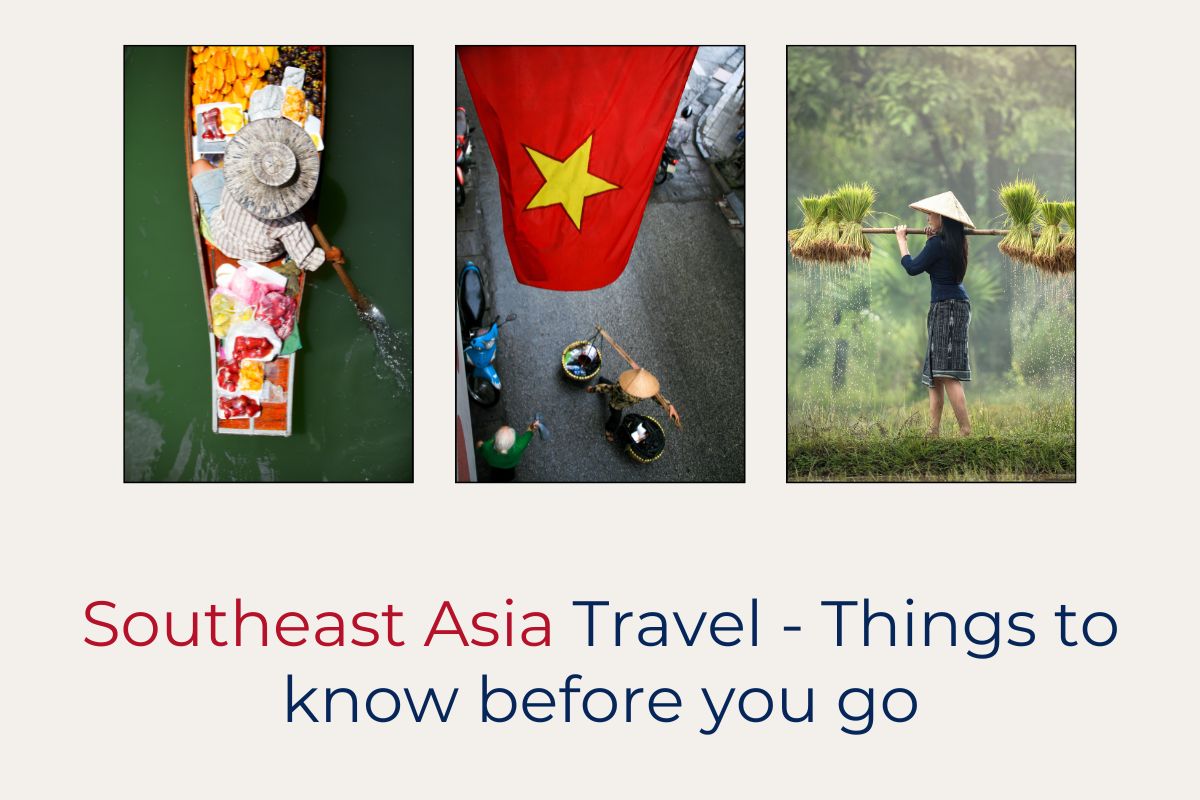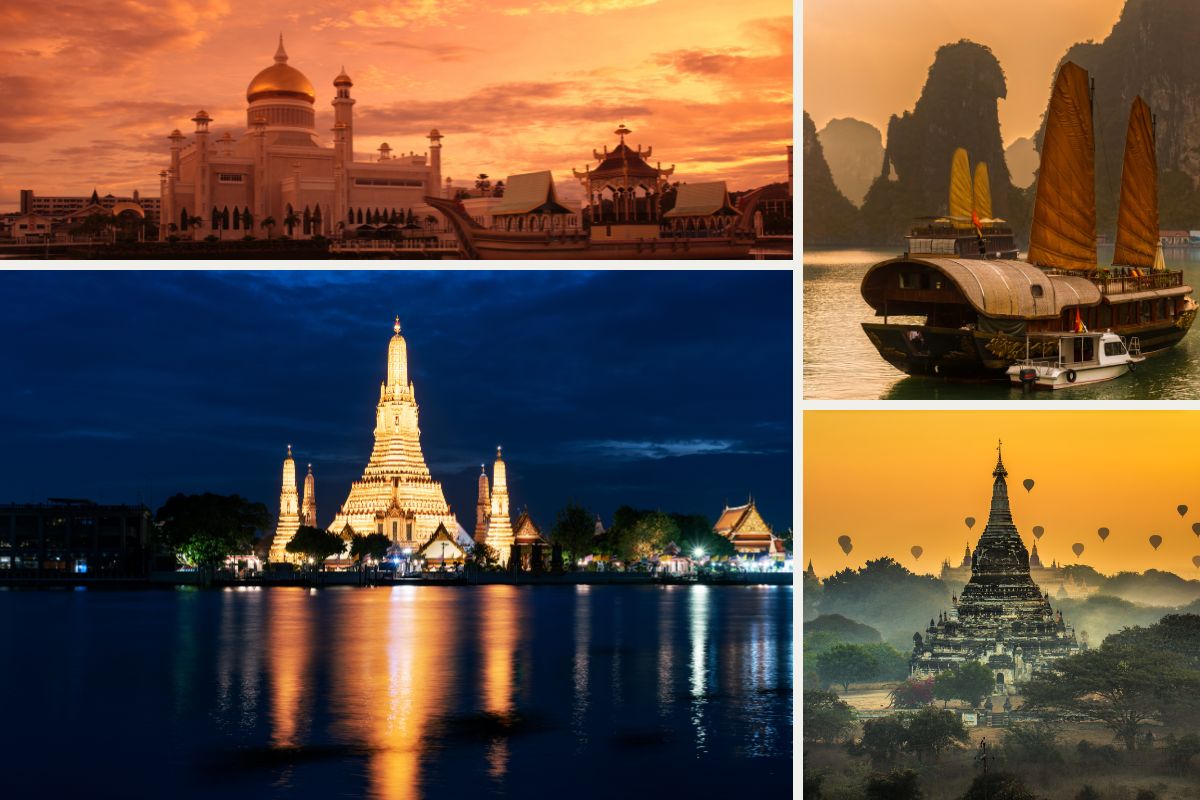Southeast Asia is one of the most sought-after travel destinations in recent years, drawing millions of travelers each year with its stunning landscapes, rich cultural heritage, and diverse culinary delights. Spanning countries like Thailand, Vietnam, Indonesia, Malaysia, and the Philippines, this vibrant region is a melting pot of traditions, languages, and experiences waiting to be explored. However, before you embark on your Southeast Asia adventure, there are a few essential things you should know to make the most of your journey. In this blog post, we will delve into various aspects of traveling through Southeast Asia—from safety concerns to what to eat—so you can navigate this enchanting region with confidence.

Table of Contents
Is Southeast Asia Safe for Travel?
Travel safety is often at the forefront of every traveler’s mind, especially when venturing into regions that may have different cultures and norms.
General Safety Considerations
Southeast Asia is generally considered safe for tourists; however, it’s essential to remain vigilant. Petty crimes such as pickpocketing, bag snatching, and scams can occur, particularly in crowded tourist areas or cities. It’s advisable to keep your valuables secured, avoid displaying expensive belongings, and stay aware of your surroundings.
Travelers should also be cautious about their transportation choices. While public transport is convenient and affordable, it’s crucial to use reputable services or ride-sharing apps to ensure safety. Additionally, some rural or isolated areas might lack adequate emergency services, so always have a backup plan and share your itinerary with someone trustworthy.
Health Precautions
Health considerations are paramount while navigating Southeast Asia’s tropical climate. Vaccinations for common diseases such as hepatitis A, typhoid fever, and even rabies may be recommended by health professionals before your trip. It is also important to carry a basic first-aid kit, along with any necessary prescription medications.
In many countries, access to standard medical care can vary greatly, so understanding local healthcare options and carrying travel insurance that covers health emergencies can provide peace of mind.
Cultural Sensitivities
Understanding cultural norms is essential for ensuring a positive experience while traveling. Southeast Asia is home to numerous religions and belief systems; hence, modest clothing is often appreciated, especially when visiting temples and religious sites.
Familiarizing yourself with local customs—even simple gestures such as greeting or eating etiquette—can enrich your interactions with locals and help you avoid inadvertently offending someone.
Southeast Asia Travel: Best time to visit
Southeast Asia boasts a tropical climate, characterized by wet and dry seasons that vary from country to country.
Seasonal Breakdown
The best time to visit Southeast Asia typically falls between November and February. During these months, the weather is cooler and less humid, making it ideal for outdoor activities and sightseeing. Coastal regions such as Thailand’s islands experience pleasant conditions during this period, attracting beachgoers and adventure seekers alike.
On the flip side, the monsoon season, which usually spans from May to October, can bring heavy rains, particularly in countries like Cambodia and Laos. While the rain can create lush landscapes, traveling during this time demands flexibility regarding itineraries and outdoor plans.

Destination-Specific Insights
Each country within Southeast Asia has its peak travel season. For instance, Bali is most enjoyable from April to September, while Vietnam’s best weather occurs from September to November. If you’re considering multiple countries, it’s prudent to research the ideal times specific to each destination to maximize your experience.
Off-Peak Travel Advantages
Traveling during off-peak months can offer unique advantages, including fewer crowds and lower prices for accommodation and activities. This creates opportunities for more authentic interactions with locals and allows for leisurely exploration without the hustle and bustle typical of high tourist seasons.
Visa for Southeast Asia
Navigating visa requirements can be daunting, but knowing what to expect will ease the process.
General Visa Information
Visa policies differ significantly among Southeast Asian countries, with some offering visa-free entry or visa-on-arrival options for many nationalities. For example, Thailand permits visitors from several countries to enter for up to 30 days without a visa. However, travelers should check individual country regulations to understand how long they can stay and the requirements for extensions if needed.
E-Visas and Online Applications
Many countries have introduced e-visas, making it easier to apply ahead of time. Countries like Myanmar and India now allow online applications, allowing travelers to receive their visas digitally, often expediting the process compared to traditional methods.
Important Documents
When applying for a visa, it’s crucial to have all necessary documents readily available, such as a passport with sufficient validity (typically six months beyond entry), passport-sized photographs, and proof of onward travel. Always ensure you’re informed about fees and processing times to avoid unexpected delays.
Do I Need a SIM Card to travel to Southeast Asia?
Staying connected while traveling is vital for navigating unfamiliar places, keeping in touch with fellow travelers, and sharing your experiences on social media.
Local SIM Cards
Purchasing a local SIM card upon arrival in Southeast Asia is often more cost-effective than international roaming. Many airports have kiosks where you can acquire a prepaid SIM card, providing immediate connectivity. Be sure to compare data packages and select a plan that suits your usage needs.
Additionally, various countries offer free Wi-Fi in airports, cafes, and hotels, but relying solely on public networks can be risky due to security vulnerabilities.

Using eSIM
In the digital era, using eSIM to stay connected is getting more and more popular. In Southeast Asia, the mobile internet is stable and fast so that visitors can have reliable connections while traveling here.
What to Pack for Southeast Asia
Packing wisely contributes to a comfortable and enjoyable trip.
Clothing Essentials
Lightweight, breathable clothing is essential given the tropical climate. Cotton or moisture-wicking fabrics will keep you cool during hot days. When visiting religious sites, it’s respectful to dress modestly by covering shoulders and knees.
A lightweight scarf can serve multiple purposes, from sun protection to a makeshift blanket during cooler evenings or long travels.
Footwear Considerations
Comfortable footwear is vital, particularly for those who plan to explore ancient ruins or engage in trekking. Investing in sturdy sandals or hiking shoes can prevent discomfort during excursions. Also, consider packing flip-flops for beach visits or relaxing at hostels.
Toiletries and Medications
Basic toiletries should be included in your packing list. While you can find most items in Southeast Asia, familiar brands may be harder to come across, and prices can vary. Additionally, carrying a small first-aid kit with essentials such as antihistamines and digestive aids can be useful in case of minor health issues.
How Much Does a Trip to Southeast Asia Cost?
Budgeting for your Southeast Asia trip can be straightforward, yet costs can vary widely depending on your travel style and preferences.
Accommodation Options
From budget hostels to luxurious resorts, Southeast Asia offers a range of accommodation options. Budget travelers can find dormitory beds for an affordable price, while mid-range hotels provide comfort without breaking the bank. For those seeking luxury, five-star hotels and boutique stays are plentiful, complete with amenities and stunning views.
Transportation Costs
Getting around Southeast Asia can be economical with various transportation modes. Local buses and trains are often inexpensive, while taxis and tuk-tuks may charge higher fares. Long-distance travel may involve booking flights, which can also vary in price based on demand and timing.
Daily Expenses for Food and Activities
Dining in Southeast Asia can cater to all budgets, from cheap street food to upscale restaurants. Street vendors often serve delicious meals for just a couple of dollars, while branded international restaurants may charge more. Participating in tours, entrance fees to attractions, and activities should also be factored into your daily budget.
Best Things to Do in Southeast Asia
Southeast Asia is brimming with activities and experiences to suit every traveler’s interests.
Exploring Ancient Temples
The iconic temples of Angkor Wat in Cambodia, the Uluwatu Temple in Bali, and the Golden Buddha in Bangkok stand as testaments to the region’s rich history. Each site showcases unique architecture and stories, inviting travelers to immerse themselves in the culture and spirituality of the past.
Vibrant Markets and Local Shopping
Markets in Southeast Asia are alive with color and energy. From bustling night markets in Chiang Mai to floating markets in Vietnam, these shopping hubs present an opportunity for travelers to purchase handicrafts, textiles, and local produce. Haggling is common, so don’t hesitate to negotiate for a fair price!
Island Hopping Adventures
With an abundance of beautiful islands like Phuket, Boracay, and Palawan, island hopping is a favorite activity among travelers. Whether you prefer lounging on pristine beaches or snorkeling in crystal-clear waters, the islands of Southeast Asia offer something for everyone.
FAQs
What is the currency used in Southeast Asia?
While several currencies are used throughout Southeast Asia, the US dollar is accepted in many tourist hotspots, particularly in Cambodia. Each country has its currency, so it’s wise to familiarize yourself with exchange rates and cash requirements.
Is it easy to get around Southeast Asia?
Public transport systems vary by country, but overall, getting around is relatively convenient. Major cities have efficient bus and taxi services, while rural areas may require renting scooters or utilizing ride-hailing apps.
Do you need vaccinations before traveling to Southeast Asia?
Consulting with a travel health professional is advisable to determine which vaccinations you may require based on the countries you plan to visit. Common recommendations include vaccines for hepatitis A, hepatitis B, and typhoid fever.
Conclusions
Traveling to Southeast Asia offers an incredible opportunity to immerse yourself in a world of vibrant cultures, breathtaking landscapes, and delectable cuisines. By preparing an adequate, understanding of safety practices, visa requirements, and cultural sensitivities, you’ll set the stage for an enriching experience that goes beyond surface-level tourism.
Every traveler’s journey is unique, and shaped by personal interests and encounters. Whether you’re exploring ancient temples or tasting street food delicacies, the beauty of Southeast Asia lies in the connections formed and memories created along the way. Embrace adventure, respect local traditions, and open your heart to what this magnificent region has to offer. Happy travels!